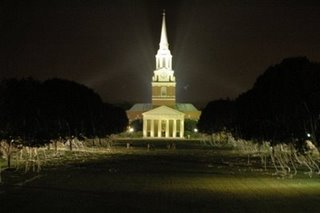Thinking back on the overall trip, there were certain dynamics that stand out as being really important. The first is the order in which we visited the cities, and the second is the breadth of the students on the trip.
I'll start with the ordering of the cities. Coming over from the US, I'm sure we all had pre-conceived perceptions of what we'd experience in this new land. Living conditions, food, the response from the local people, how well we'd adapt to the culture, the role of the gov't, etc.. Beijing exposed us to the crossroads that Chinese culture is experiencing, with the mix of incredible growth and modernization (high-rise, buildings, roads, factories) and the 100s or 1000s of years of culture that still exists in the City Walls, City Moats and neighborhood hutongs and villages. But Beijing is also the center of the Chinese government, and to a certain extent it felt like a giant maze. Trying to get anywhere was cumbersome, there was never a direct path. It constantly felt like we needed to move in concentric circles to eventually reach a destination. And then once we were there, the business meetings often felt like a painful slog of formalities and interpreters. Combined with the newly inhailed pollution, Beijing initially felt like a shiny toy (on the outside), but a visit to a grandparents house on the inside. But then an interesting thing happened, we got outside the shiny parts and were allowed to explore. We sought out the older parts of the city. We sought out the local people and native culture. And we found places like Black Sesame Kitchen and and other places that embraced their past and were combining it with the new.As we left Beijing and travelled to Xi'an, I sensed that there was some skepticism about the remainder of our trip. There was also a sense that the size and scope of China was so overwhelming that we might be too small to experience enough. Xi'an provided a nice change of pace. While it was a city of 8.3M people (the size of NYC), it didn't feel as dense. It felt more like Chicago. A big city, but further west and away from the crowds of Beijing. Xi'an showed us a new pace of growth. Xi'an is a city steeped in 3000 years of history, the origin of the legendary Silk Road, but here is was trying to become the new gateway to China's west. While Beijing had grown up, Xi'an was adding a new city area the size of Winston-Salem or Raleigh in 10-12 locations. Cranes were everywhere you looked. But Xi'an still had it's history. The Terra Cotta Warriors. The Big Wild Goose Pagoda. The Drum and Bell Towers within the ancient city wall. It had retained it's past, and was trying to build a new set of history. Overall the pace seemed to ebb and flow slightly better than Beijing, but that would all change as we got move on to Shanghai.
Traveling south to Shanghai, it almost felt like we entered a completely different China. Shanghai was new and huge and sprawling. Shanghai was not about history or tourism, it was all about being a center of business and an international metropolitan area. With 35M people, spanning an area the size of Delaware, Shanghai is massive in scope. Shanghai was our first experience of a China that had adopted many westernized ways. Transportation was a free-for-all, but it was fast paced. The business meetings moved to a different level, as the scope of the companies increased and we got insight from exPats on their experiences doing in Asia. The views of the skyline and the water were stunning, especially at night as the Asian obsession with neon was in full effect. The diversity of Shanghai was evident, as many of our group expressed a regret that we didn't have an extra to experience more of this incredible city.
Our final journey took us off the mainland and over to Hong Kong. A British territory in 1997, this felt the most like home. Hong Kong is like NYC with a British (and Cantonese) accent, set along the water and amongst the mountains. Language was no longer a barrier. The business meetings we again face-paced and engaging with exPats or Hong Kong locals.
About halfway through the second week, somewhere between Shanghai and Hong Kong, it started to dawn on us that the trip Mike Lord had created was the perfect blend of experiences for us to truly experience China. It started out slow and formal, highlighting the differences of doing business on the mainline. It showed the importance of local relationships (ours was with Kathy Guan of CITIC Travel), and the customs of interacting with State Owned Entities (SOE). We experienced the challenges of navigating in a country with a massive population and a communist government that needed to manage the growth in a controlled manner. As the trip progressed, we stated to see more freedoms and change, and we continued to see how capitalism and communism were intertwined. By the end of the first week, many of our preconceptions had been proven wrong, and we began to truly understand the incredible energy that was here. If we had experienced the cities in the opposite order, it would have been like driving a Ferrari at 150mph and then suddenly hitting the brakes to go down a one-land road. It would have created frustration. By putting the itinerary in this order, we were forced to experience eastern China first, to get outside our comfort zone and to learn to adapt. Only later woud we partake in the China that had an aspect of comfort for us, and we were all better for it. We had adjusted to the culture, the expectations and the nuances.



